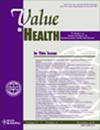基于 QALY 的 CEA 对残疾患者的鉴别特性:杜氏肌肉萎缩症个案研究。
IF 6
2区 医学
Q1 ECONOMICS
引用次数: 0
摘要
目的:质量调整生命年(QALYs)作为衡量残疾人获益的标准一直受到质疑,尤其是那些处于低效用健康状态或有不可逆转残疾的人。本研究探讨了基于 QALY 的评估对杜兴氏肌营养不良症(DMD)(一种进行性遗传神经肌肉疾病)假定治疗价格的影响:复制、验证并调整了之前发表的五国模型,该模型分析了早期非卧床 (EA) DMD 患者的治疗方法,并将早期非卧床 (ENA) DMD 患者也纳入其中。该模型用于评估 13 岁 ENA 和 5 岁 EA 患者(初始健康状况分别为效用较低和较高)假设治疗的基于 QALY 的阈值价格(最高成本效益价格)。所有投入都是重复的,包括 50,000 至 200,000 美元/QALY 的支付意愿(WTP)阈值:结果:与 EA 患者相比,ENA 患者在 WTP 为 15 万美元/QALY 或更高时,尽管治疗效果相同(病情恶化/死亡延迟),但基于 QALY 的阈值价格模型下降了 98%。在100,000美元/QALY或更低的情况下,非治疗净成本超过了健康收益,这意味着对ENA患者的任何治疗都不会被认为具有成本效益,即使是0美元的价格,包括无限期暂停疾病进展:结论:对于某些严重的致残性疾病,传统方法很可能会得出这样的结论:一旦患者的健康状况发展到致残状态,且效用价值较低,那么无论采用何种价格,治疗都不具有成本效益。这些发现从理论/伦理角度阐明了传统 QALY 评估对残疾人,尤其是失去行动能力或有其他身体限制的残疾人的潜在歧视性。本文章由计算机程序翻译,如有差异,请以英文原文为准。
Discriminatory Properties of the Quality-Adjusted Life Year Based Cost-Effectiveness Analyses for Patients With Disabilities: A Duchenne Muscular Dystrophy Case Study
Objectives
Quality-adjusted life years (QALYs) have been challenged as a measure of benefit for people with disabilities, particularly for those in low-utility health states or with irreversible disability. This study examined the impact of a QALY-based assessment on the price for a hypothetical treatment for Duchenne muscular dystrophy (DMD), a progressive, genetic neuromuscular disease.
Methods
A previously published, 5-state model, which analyzed treatments for early ambulatory (EA) DMD patients, was replicated, validated, and adapted to include early nonambulatory (ENA) DMD patients. The model was used to assess a QALY-based threshold price (maximum cost-effective price) for a hypothetical treatment for 13-year-old ENA and 5-year-old EA patients (initial health states with lower and higher utility, respectively). All inputs were replicated including willingness-to-pay thresholds of $50 000 to $200 000/QALY.
Results
In contrast to EA patients, ENA patients had a 98% modeled decline in QALY-based threshold price at a willingness-to-pay of $150 000/QALY or higher, despite equal treatment benefit (delayed progression/death). At $100 000/QALY or lower, net nontreatment costs exceeded health benefits, implying any treatment for ENA patients would not be considered cost-effective, even at $0 price, including an indefinite pause in disease progression.
Conclusions
For certain severe, disabling conditions, traditional approaches are likely to conclude that treatments are not cost-effective at any price once a patient progresses to a disabled health state with low utility value. These findings elucidate theoretical/ethical concerns regarding potential discriminatory properties of traditional QALY assessments for people with disabilities, particularly those who have lost ambulation or have other physical limitations.
求助全文
通过发布文献求助,成功后即可免费获取论文全文。
去求助
来源期刊

Value in Health
医学-卫生保健
CiteScore
6.90
自引率
6.70%
发文量
3064
审稿时长
3-8 weeks
期刊介绍:
Value in Health contains original research articles for pharmacoeconomics, health economics, and outcomes research (clinical, economic, and patient-reported outcomes/preference-based research), as well as conceptual and health policy articles that provide valuable information for health care decision-makers as well as the research community. As the official journal of ISPOR, Value in Health provides a forum for researchers, as well as health care decision-makers to translate outcomes research into health care decisions.
 求助内容:
求助内容: 应助结果提醒方式:
应助结果提醒方式:


